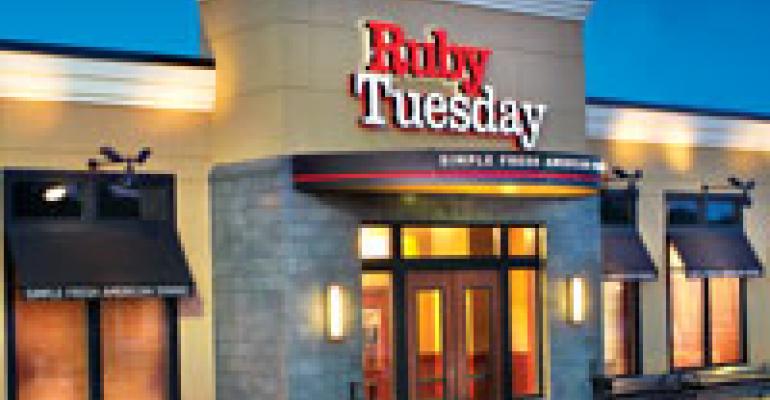MARYVILLE Tenn. Ruby Tuesday Inc. has been the poster child for all the woes of casual dining for the past two years. That may have come to a halt this week.
The company, which operates or franchises 902 restaurants, reported third-quarter adjusted profit that topped Wall Street estimates, and the company said its 2009 loss would be smaller than previously expected. It heralded cost control and debt reduction and noted that monthly sales trends, while still negative, have improved sequentially from December through March.
Investors rewarded the company with a 57-percent surge in the company stock price, to $6.10 on Wednesday, and analyst after analyst raised their price targets and cautiously suggested that the chain may have turned the corner. Over the past 52 weeks, Ruby Tuesday's stock has traded between 85 cents and $9.25 a share.
“We were encouraged by management’s ability to expand margins with pro-active cost controls at both the restaurant and corporate levels, sequentially improve same-store sales throughout the quarter with a refined marketing focus and pay down $40 million of debt,” said Lynne Collier, a restaurant analyst at Keybanc Capital Markets. “Looking forward, we expect further margin expansion and same-store sales improvements.”
Ruby Tuesday, based in Maryville, Tenn., has had a tough road. Like many of its peers in casual dining, customer traffic began to decline in 2006, as bar-and-grill restaurants fell out of favor with consumers — the victims of overbuilding and concept similarity, observers noted. With the beginning of the domestic economic downturn hitting in late 2007, casual dinnerhouses were already facing an uphill battle, and in 2008, skyrocketing costs and a slowdown in consumer spending combined to create a perfect storm.
Ruby Tuesday saw its stock price fall 63 percent in 2007. It fell 83 percent in 2008.
The chain, which includes 671 corporate restaurants, tried to stem the tide with a revamped menu highlighting higher-priced fare, remodeled locations, new marketing and advertising and a focus on guest service. With a more upscale feel to the brand, Ruby Tuesday lost some traffic from penny-pinching consumers. The chain quickly changed momentum, however, and has most recently focused on value offerings. A new buy-one-get-one free promotion began in February, and some units are promoting $10 bottles of wine.
The efforts have helped keep continuing sales slides at bay. Same-store sales at corporate locations fell 9 percent in December, 5.9 percent in January and 5.1 percent in February. The company did not reveal specifics, but said March results showed additional improvement.
“This is as difficult of an operating environment as I’ve ever seen,” Sandy Beall, Ruby Tuesday's chairman, president and chief executive, said during a conference call with investors. “Nonetheless, I’ve never felt better about how we are operating our restaurants and our business.”
In addition to sales momentum, the company said it would continue to cut costs, pay down debt — which stands at about $507 million — and cut back on development. The company also reiterated its plans to close as many as 30 locations during the next few years. In January and February, the company closed 40 restaurants.
For the quarter ended March 3, Ruby Tuesday earned $4.8 million, or 9 cents per share, compared with earnings of $11.7 million, or 23 cents per share, in the same quarter a year earlier. In the latest quarter, the company booked restaurant closure and impairment expenses of $14.6 million, which reduced per-share earnings by 17 cents. Excluding those items, Ruby Tuesday would have earned 26 cents per share, well above the average analyst expectation for adjusted per-share earnings of 11 cents, according to Thomson Financial.
Ruby Tuesday’s third-quarter revenues fell nearly 10 percent to $317.5 million, reflecting fewer restaurants and a quarterly same-store sales decline of 6.8 percent.
The company now expects annual same-store sales to fall between 8 percent and 9 percent from the year earlier. It also will close a net of 48 restaurants for the year, which ends in May.
Still, because of the better-than-expected results in the third quarter, the company’s expectations for a full-year loss were narrowed by 5 cents per share to between 40 cents and 50 cents. That net loss will include 88 cents per share for restaurant closures and impairment, the company reported. Ruby Tuesday booked a profit of 51 cents per share a year earlier.
Contact Sarah E. Lockyer at [email protected].





